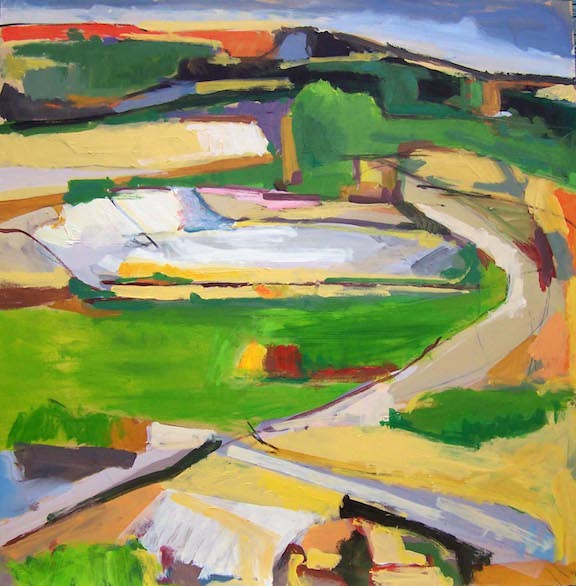Arts & Entertainment
Arts & Entertainment
Warwick Landscapes in Abstract: Fall Into Winter
- Details
- Published: 19 November 2014 19 November 2014
Last summer I created a collection of work during a plein air painting holiday in County Meath, Ireland. This Fall I was reminded of the lush green landscape of Ireland and decided to paint our beautiful Warwick Landscape. This series of paintings "Fall into Winter" was created on location inspired by Upper and Lower Wisner Road, Ochs Orchard, and Applewood Orchards.
"There's Just Something about Pumpkins"... Up Close with Artist Nancy Reed-Jones
- Details
- Published: 15 October 2014 15 October 2014
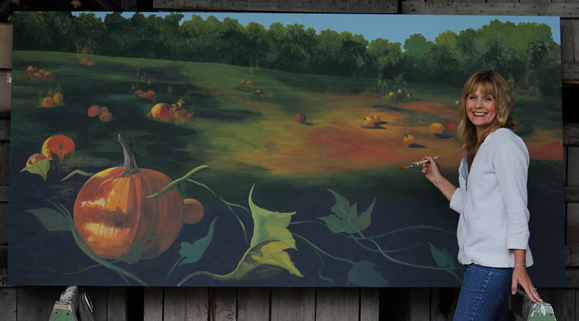
George: I really like this photo of you standing in front of your mural with the pumpkins. How did it come about?
Nancy: I painted the mural at Soons Orchards last fall as part of the "Farm Art Trail" with the Wallkill River School. One artist painted on each farm where people could watch and also learn more about the farm and the Wallkill River School and their mission. I painted three large panels, each depicting a different part of the farm.
The first was Soons apple orchards where I also included one of the family dogs. The second was of the Pumpkin Patch and the third of the actual farm stand building. While we were painting the mural groups of people took tours of the farm and watched the painting being done.
I love the fact that something that I created will be part of Soons Orchards for years to come.
George: How do you feel about painting around this time of year?
Nancy: The autumn season is my favorite time of year. I think of it as "Gods Art Show" and it is like no other. We artists pale in comparison to the magnificent array of colors that he can produce as our creator.
I especially love painting en plein air in the fall when everything surrounding us has a warm glow about it. I feel it is produced by a magical force right before the landscape goes to sleep for the winter.
George: Tell us about your recent Pumpkin Painting that sold?

Nancy: This painting is titled "The Harvest." I included two of my autumn favorites in this painting. One is my love of mums because they show the true colors of autumn. The other is pumpkins.They remind me of the beautiful region we live in and of happy memories as a child picking pumpkins in the pumpkin patch.The person who purchased my painting has stated that it will hang in her dining room for the fall and holiday season.
George: You also teach. What's it like teaching your classes?
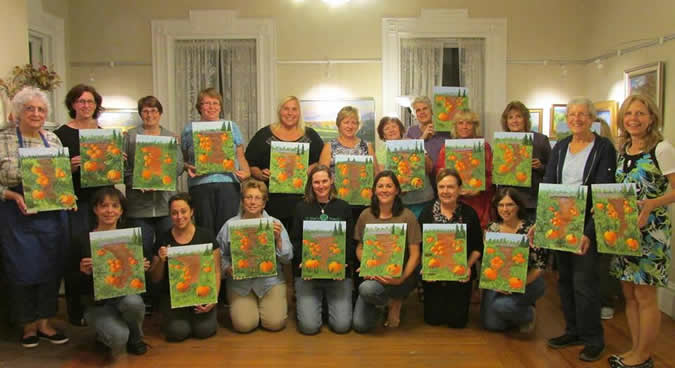
Nancy: Even with my great love of painting, I must say I really enjoy the teaching aspect of it as well. I teach beginner "Arty Parties" every Thursday evening at the Wallkill School Of Art. Students are encouraged to bring their favorite wine, snacks and paint in a party atmosphere. Even if a student has never painted before, they leave my class knowing that everyone has the ability to create art. I work with each person at the level they are at and encourage them to be creative in their own right, while creating a safe and non judgmental environment for them. I really enjoy having these very large classes because even though everyone is painting the same scene, they somehow all turn out just a little different. I love seeing the faces of the students who never knew they could paint. I feel very blessed to have the ability to unleash in my students their artistic abilities that were unknown to them.
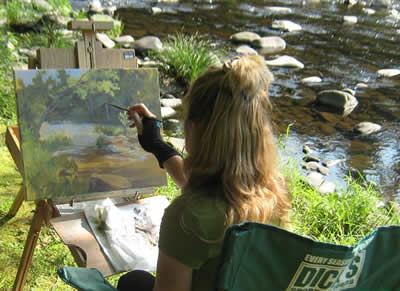 Bio: Nancy Reed Jones came to the Hudson Valley from Long Island in 2004, where she owned her own mural business for several years. While living on Long Island, Nancy painted murals for cancer patients at a hospital there. Her murals were used for "guided imagery" to help alleviate the patients pain. Nancy also taught "Art For Relaxation" classes to the nurses and doctors at the hospital.
Bio: Nancy Reed Jones came to the Hudson Valley from Long Island in 2004, where she owned her own mural business for several years. While living on Long Island, Nancy painted murals for cancer patients at a hospital there. Her murals were used for "guided imagery" to help alleviate the patients pain. Nancy also taught "Art For Relaxation" classes to the nurses and doctors at the hospital.
In 2008 Nancy joined the Wallkill River School of Art in Montgomery where she is now an instructor and on the Board Of Directors.
In 2013 she was awarded the "Champion Of The Arts In Healthcare" award by the Orange County Arts Council and in 2010 was voted #1 acrylic artist in the region.
Under the Sol Niger: The Paintings of Juanita Guccione
- Details
- Published: 12 September 2014 12 September 2014
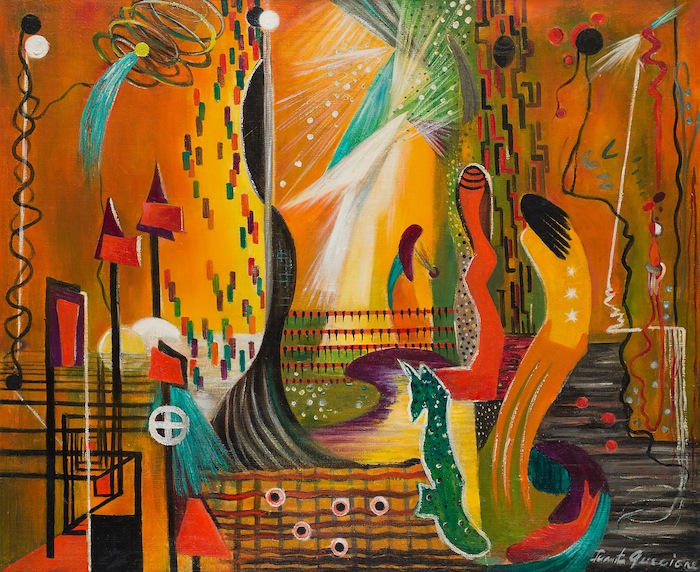
Like many of the women artists associated (even peripherally) with Surrealism, Juanita Guccione eschewed labels of any kind, and with good reason. Her life was rich with diverse artistic mentors, spiritual traditions, and creative developments that make it impossible to reduce her nuanced body of work to one movement. Nevertheless, Surrealism’s wide cultural influence, particularly strong in the United States during World War II when many of its artists were exiled and living in New York City, is not to be underestimated. Guccione, who met Surrealism’s founder and leader André Breton at this time, was drawn (like many women artists from the Americas and elsewhere), to the potentials of its pictorial language.
As the scholar Gloria Feman Orenstein astutely observes, the women artists associated with the surrealist movement can be conceptually linked with Breton’s conception of “The Great Transparents,” a proposition he developed while in exile in New York, that banished Man from the mythological center of the universe in an attempt to create a new and more relevant mythological structure for humanity. Orenstein states: “The women artists of the surrealist movement can be perceived metaphorically as the Great Transparents, as Breton defines them – beings whose stature and significance is immense, but who are overlooked and dismissed as nonexistent.”[1] Orenstein firmly places Guccione in this category, noting the artist’s formation of realms presided over by powerful and strong Amazon-like women, such as those seen in Masquerade (c. 1946). As she and Djelloul Marbrook attest, this was likely due to Guccione’s earlier and formative experiences with the Ouled Naïl, a matriarchal tribe in Algeria that she lived in close proximity to.
The influence of Surrealism, however, can also be seen in Guccione’s earlier abstract paintings from the late 1930s and early 1940s – before her contact with Breton. In works such as Christmas (c. 1937) and Distractions (1940) there is a bright color palette, rhythmic arrangement of form, and use of organic shapes that bear some pictorial relation to the works of Joan Miró and others working in a biomorphic surrealist style. Around this time the artist begins to insert certain symbols that reflected her life-long interest in esoteric belief systems such as Sufism, Rosicrucianism, Theosophy, Kabala, Tarot and astrology. Checkered floors, crosses, orbs of light, stairways, and spirals suggest secret codes and access to alternate dimensions. Cosmological configurations such as comet-like flashes, crescent moons and full moons appear frequently and transition into her figural work where they take a more prominent position.
The Sol Niger of alchemical traditions and Jungian psychology becomes a signature emblem for Guccione, hovering in dramatic skies streaked with unearthly colors to create a haunting and mysterious ambience. The black sun can represent the melancholy of the artist who metaphorically must explore darkness in order to gain greater self-knowledge, or perhaps the transformation of trauma into growth and life. In Acrobats (c.1949) two androgynous figures set in a metaphysical landscape have chin in hand in the age-old gesture of contemplation and sadness. Under a Sol Niger a black and white checkerboard floor hints at the reconciliation of opposites while the rope ladders of circus performers suggest ascension and transformation. Painted in 1955, On the street of chance displays a plethora of gaming equipment, again under a black sun set in an apocalyptic sky. Aside from any personal meaning for the artist, one cannot help but recall the surrealist love of the role of chance and play in artistic production.
Guccione’s late work is particularly engaging as by then she had condensed the various strains of her work into a singular vision where strong color in combination with her arsenal of symbols attain a lyrical crescendo. In Vigil (c. 1983) floating ears and eyes accompany a figure seated near stairs (a medium channeling sights and sounds?) – while fantastical orbs of light joyously skim across the vibrant purple background. By this time the New Age Movement is in full stride and Guccione’s work seems not only to have heralded its coming, but her entire oeuvre can now be understood more respectfully by a population conversant in esoteric color symbolism and cryptic emblems. Juanita Guccione’s art was undoubtedly ahead of its time, and luckily for us we have the opportunity to fully savor its beauty and more thoughtfully contemplate its layers of meaning.
[1] Gloria Feman Orenstein, “Down the Rabbit Hole: An Art of Shamanic Initiations and Mythic Rebirth.” In Wonderland: The Surrealist Adventures of Women Artists in Mexico and the United States, Los Angeles County Museum of Art. Los Angeles: 2012, 74.

